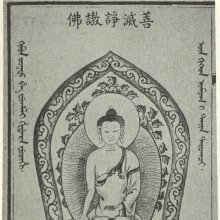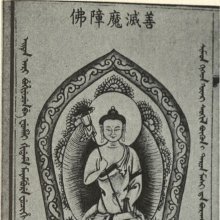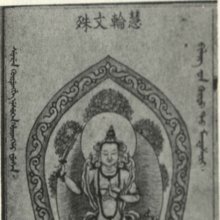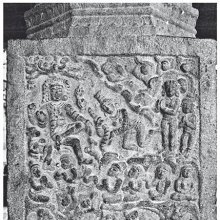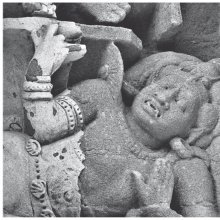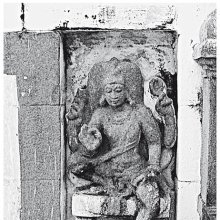Dan, Ḍaṇ, Dān: 11 definitions
Introduction:
Dan means something in Hinduism, Sanskrit, the history of ancient India, biology. If you want to know the exact meaning, history, etymology or English translation of this term then check out the descriptions on this page. Add your comment or reference to a book if you want to contribute to this summary article.
Images (photo gallery)
(+3 more images available)
In Hinduism
Vyakarana (Sanskrit grammar)
Source: Wikisource: A dictionary of Sanskrit grammarḌaṇ (डण्).—tad. affix अ (a), causing vrddhi and टिलोप (ṭilopa), applied to त्रिंशत् (triṃśat) and चत्वारिंंशत् (catvāriṃṃśat) to show the परिमाण (parimāṇa) i.e. measurement or extent of a Brahmana work; e.g. त्रैंशानि ब्राह्मणानि, चात्वरिंशानि (traiṃśāni brāhmaṇāni, cātvariṃśāni) cf. P. V. I.62
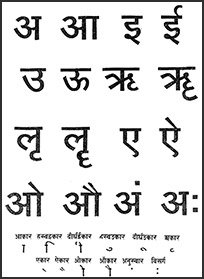
Vyakarana (व्याकरण, vyākaraṇa) refers to Sanskrit grammar and represents one of the six additional sciences (vedanga) to be studied along with the Vedas. Vyakarana concerns itself with the rules of Sanskrit grammar and linguistic analysis in order to establish the correct context of words and sentences.
India history and geography
Source: Shodhganga: Vernacular architecture of Assam with special reference to Brahmaputra ValleyDan is an Assamese term referring to “[or danda] the passageway of the spirits in the site selection system of danda-bheti-choa”.—It appears in the study dealing with the vernacular architecture (local building construction) of Assam whose rich tradition is backed by the numerous communities and traditional cultures.

The history of India traces the identification of countries, villages, towns and other regions of India, as well as mythology, zoology, royal dynasties, rulers, tribes, local festivities and traditions and regional languages. Ancient India enjoyed religious freedom and encourages the path of Dharma, a concept common to Buddhism, Hinduism, and Jainism.
Biology (plants and animals)
Source: Google Books: CRC World Dictionary (Regional names)1) Dan in Burma is the name of a plant defined with Lawsonia inermis in various botanical sources. This page contains potential references in Ayurveda, modern medicine, and other folk traditions or local practices It has the synonym Rotantha combretoides Bak. (among others).
2) Dan in India is also identified with Senna tora It has the synonym Cassia obtusifolia var. humilis (Collad.) Torr. & A. Gray (etc.).
3) Dan in Senegal is also identified with Pennisetum pedicellatum It has the synonym Eriochaeta secundiflora Fig. & De Not. (etc.).
4) Dan in Sri Lanka is also identified with Syzygium caryophyllatum It has the synonym Jambosa caryophyllata (L.) Bedevian (etc.).
Example references for further research on medicinal uses or toxicity (see latin names for full list):
· Journal of Cytology and Genetics (1988)
· Histoire Naturelle et Médicale des Casses (1816)
· Biol. Pl. (1982)
· Harvard Papers in Botany (2005)
· Plant Systematics and Evolution (1986)
· Ethnobotany (1999)
If you are looking for specific details regarding Dan, for example extract dosage, chemical composition, pregnancy safety, side effects, health benefits, diet and recipes, have a look at these references.

This sections includes definitions from the five kingdoms of living things: Animals, Plants, Fungi, Protists and Monera. It will include both the official binomial nomenclature (scientific names usually in Latin) as well as regional spellings and variants.
Languages of India and abroad
Sanskrit dictionary
Source: DDSA: The practical Sanskrit-English dictionaryDān (दान्).—1 U. (dānati-te) To cut, divide. -Desid. (dīdāṃsatite) To make straight; (desid. in form, but not in sense).
Source: Cologne Digital Sanskrit Dictionaries: Shabda-Sagara Sanskrit-English DictionaryDān (दान्).—[(u) dānu] r. 1st cl. irr. (dīdāṃsati-te) 1. To cut. 2. To straighten or make straight. 2. To be straight. bhvā0 ubha0 saka0 .
Source: Cologne Digital Sanskrit Dictionaries: Benfey Sanskrit-English DictionaryDān (दान्).—i. 1, [Parasmaipada.], [Ātmanepada.] i. 10, [Parasmaipada.] To cut. Desider. dīdāṃsa, [Parasmaipada.], [Ātmanepada.] 1. To be straight. 2. To make straight.
Source: Cologne Digital Sanskrit Dictionaries: Cappeller Sanskrit-English DictionaryDan (दन्).—1. only in patirdan & patī dan ([vocative] [dual]) = daṃpati & daṃpatī.
--- OR ---
Dan (दन्).—2. only danas & dan straighten.
Source: Cologne Digital Sanskrit Dictionaries: Monier-Williams Sanskrit-English Dictionary1) Dan (दन्):—danas See dat, 2. and 1. dam.
2) [according to] to some [from] √daṃs, ‘to make straight’, either ‘to raise, erect’, or ‘to put right, rule, guide, manage’; in some places probably = ‘a guide, manager, institutor’.
3) Dān (दान्):—([Dhātupāṭha xxiii, 25]) [class] 1. [Ātmanepada] [Parasmaipada] and 10. [Parasmaipada] dānati, te and nayati, to cut off;
— [Desiderative] [Ātmanepada] [Parasmaipada] dīdāṃsati, te, to be or make straight, [Pāṇini 3-1, 6.]
Source: Cologne Digital Sanskrit Dictionaries: Yates Sanskrit-English DictionaryDān (दान्):—(u) dīdāṃsati, te 1. c. irr. To cut, make straight, be straight.
[Sanskrit to German]
Sanskrit, also spelled संस्कृतम् (saṃskṛtam), is an ancient language of India commonly seen as the grandmother of the Indo-European language family (even English!). Closely allied with Prakrit and Pali, Sanskrit is more exhaustive in both grammar and terms and has the most extensive collection of literature in the world, greatly surpassing its sister-languages Greek and Latin.
See also (Relevant definitions)
Starts with (+2045): Daankhli, Daanpha, Damdabhrama, Damdabhramari, Damdadaya, Damdadhisha, Damdadhyakshaka, Damdadravya, Damdagayi, Damdahagolisu, Damdahyamana, Damdajne, Damdakamta, Damdakhamda, Damdakolu, Damdalaia, Damdale, Damdama, Damdamderu, Damdamgol.
Ends with (+793): Aadan--pradaan, Aakaasagarudan, Aba odan, Abadan, Abhinandan, Abhivadan, Abhivandan, Abhyudan, Acajou du soudan, Acchodan, Accutan, Achchhadan, Achchhedan, Achchhodan, Acintitan, Adan, Agbon odan, Ahadan, Ai-tarunatan, Aidan.
Full-text (+266): Shuddhadat, Dvidat, Caturdat, Pradam, Daulatadara, Geeron dan kaaruwa, Thermopsis inflata, Sadanuvritti, Upakappana, Randananda, Muniri dan, Wo dan, Sadanukaladarshini, Ribes alpestre, Cayitan, Bai hua dan, San dan, Aloma dan, Dan magami, Ubhayatodat.
Relevant text
Search found 59 books and stories containing Dan, Ḍaṇ, Dān; (plurals include: Dans, Ḍaṇs, Dāns). You can also click to the full overview containing English textual excerpts. Below are direct links for the most relevant articles:
Sahitya-kaumudi by Baladeva Vidyabhushana (by Gaurapada Dāsa)
Text 10.76 < [Chapter 10 - Ornaments of Meaning]
Shakti and Shakta (by John Woodroffe)
Appendix I - Quelqes Concepts Fondamentaux des Hindous < [Appendices]
Appendix II - Quelqes Observations Sur Le Rituel Hindou < [Appendices]
Chapter XI - Śakti in Taoism < [Section 1 - Introductory]
Rig Veda (translation and commentary) (by H. H. Wilson)
The Agni Purana (by N. Gangadharan)
Śrī Kṛṣṇa-vijaya (by Śrī Gunaraja Khan)
Blue Annals (deb-ther sngon-po) (by George N. Roerich)
Chapter 1 - Chronology of the later spread of the teaching < [Book 2 - Later spread of the Doctrine]
Chapter 1c - The Zur Geneology (xxi): Summary of mdo and Māyā < [Book 3 - Early translations of Secret Mantra]
Chapter 1 - Translator Rngog together with his lineage < [Book 6 - The Origin of the Mādhyamika (middle way)]
Related products
